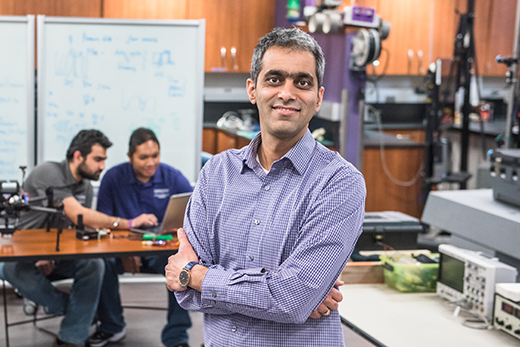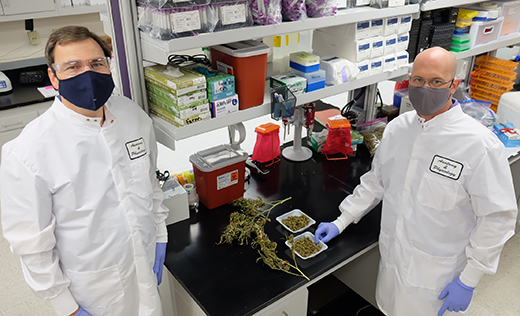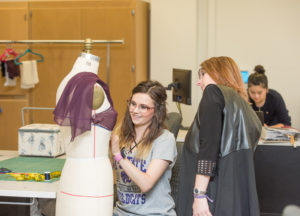09/02/20
K-State Current - September 2, 2020
K-State Current is a weekly news update for the Kansas Board of Regents to apprise the Regents on a few of the many successes and achievements made by K-State faculty, staff and students.
K-State News
USDA funds technology research for optimum production from better, smarter planting
 In a collaborative effort with crop producers, researchers at Kansas State University will introduce the latest technologies for precision planters to help enhance productivity and maximize yield.
In a collaborative effort with crop producers, researchers at Kansas State University will introduce the latest technologies for precision planters to help enhance productivity and maximize yield.
With nearly $300,000 in funding from the U.S. Department of Agriculture's Research Education and Economics — National Institute of Food and Agriculture program, a team led by Ajay Sharda, associate professor in the Carl and Melinda Helwig Department of Biological and Agricultural Engineering, will pursue "Enhancing Crop Productivity by Developing Operational Strategies for High-Speed Precision Seeding Technologies."
The three-year project involves conducting on-farm studies in collaboration with producers to better understand planter control system dynamics during high-speed planting. This will be observed under varying seeding rates, row spacing, planting depths, tillage systems, and weather and soil types.
"We will establish recommendations for producers to smartly implement machine operating parameters to achieve uniform emergence. This in turn will improve stand establishment, early-season growth and yield optimization on a row-by-row basis," said Sharda, a Patrick Wilburn — Carl and Mary Ice Keystone research scholar in the Carl R. Ice College of Engineering at K-State.
On-farm research with producers as partners will provide a metric to assess the advantages of adopting precision planter technologies — not only from the machinery but also from the agronomic perspective with the ultimate goal of improving overall productivity and profitability.
"This will develop strong extension and applied research programs for disseminating this material," Sharda said. "It will showcase best management practices for optimizing current precision planter technologies to achieve uniform seed placement and gain yield advantages."
The project will require Sharda and K-State co-collaborators Ignacio Ciampitti, agronomy, and Edwin Brokesh, biological and agricultural engineering, to adopt novel methodologies and robust high-frequency data acquisition systems for gathering detailed machinery and agronomic data.
"Collecting this multiyear, large scale on-farm research data," Sharda said, "will not only allow our students to work with state-of-the-art technologies for their professional development, but will also enhance K-State's research capacity to engage with numerous research partners to conduct collaborative large-scale on-farm research."
Engagement and support will also be provided by Kansas extension agents Tony Whitehair, Dickinson County, and David Hallauer, Meadowlark Extension District.
K-State research among first to analyze safety of industrial hemp as cattle feed
 Kansas State University veterinary researchers Hans Coetzee, left, and Michael Kleinhenz are studying the safety of using industrial hemp in feed for cattle.
Kansas State University veterinary researchers Hans Coetzee, left, and Michael Kleinhenz are studying the safety of using industrial hemp in feed for cattle.
A pair of studies at Kansas State University is bringing new insight to farmers and producers seeking to incorporate industrial hemp in cattle feed.
After the 2018 Farm Bill legalized hemp production in the U.S., interest has grown in industrial hemp as an agricultural commodity, including as feed for animals. FDA approval, however, through the Association of American Feed Control Officials would be required before hemp could be fed to livestock or pets.
"Although hemp can be legally cultivated under license in Kansas, feeding hemp products to livestock remains prohibited because the potential for cannabinoid drug residues to accumulate in meat and milk has not been studied," said Hans Coetzee, professor and head of the anatomy and physiology department in the College of Veterinary Medicine.
A team of K-State researchers recently received a $200,000 Agriculture and Food Research Initiative Competitive Grant from the U.S. Department of Agriculture's National Institute of Food and Agriculture to establish concentrations of cannabinoids in livestock after exposure to industrial hemp.
"Industrial hemp is typically grown to produce oil, seed, fiber and medicines," said Michael Kleinhenz, assistant professor of beef production medicine. "While varieties of hemp may be planted for a single or dual purpose, such as for seed and fiber, byproducts consisting of leaves, fodder and residual plant fibers remain after harvest. These byproducts could serve as potential feedstuffs for animals. Because these are predominantly cellulose-containing plant materials, the ideal species for utilizing these feeds are ruminant animals, specifically cattle."
While there is interest in the use of hemp for cattle feeds, there are questions about whether the feed can be used safely because of concerns about tetrahydrocannabinol, or THC, intoxication and the presence of other bioactive cannabinoids. Kleinhenz noticed that most research was focused on humans, mice and swine, but not on cattle.
"This is surprising because cattle can readily utilize industrial hemp byproducts as they can digest cellulose plant materials in their rumens," Kleinhenz said.
Kleinhenz is part of a multidisciplinary research team consisting of pharmacologists, toxicologists, analytical chemists and horticulture experts. The hemp used in the studies was grown at K-State's John C. Pair Horticultural Center near Wichita. Other K-State researchers involved include Geraldine Magnin, Zhoumeng Lin, Steve Ensley, Jason Griffin, Katie E. Kleinhenz, Shawnee Montgomery, Andrew Curtis, Miriam Martin and Coetzee. The research team also included John Goeser and Eva Lynch, Rock River Laboratories.
"We observed that the acidic cannabinoids, such as CBDA and THCA, are more readily absorbed from the rumen than other nonacid cannabinoid forms, such as CBD and CBG," Kleinhenz said. "Now that we have found that some cannabinoids are readily absorbed from the rumen, the next steps are to study the tissue and milk residue depletion profiles of these compounds after animal feeding experiments. The effects of cannabinoids on cattle are also unknown."
Follow-up experiments will include pilot studies to examine the effect of feeding hemp on animal behavior and immune function.
"Our goal is to fill in the knowledge gaps," Kleinhenz said. "Until feedstuffs containing hemp are established as safe in animals, our data will assist producers in managing situations involving intentional or unintentional hemp exposures."
The two published studies are "Nutrient concentrations, digestibility, and cannabinoid concentrations of industrial hemp plant components," which can be found in the journal Applied Animal Science, and "Plasma concentrations of eleven cannabinoids in cattle following oral administration of industrial hemp (Cannabis sativa)," which was published in Scientific Reports.
K-State Faculty Highlights
USDA-NIFA grant supports research to control respiratory disease in young swine
 A new $500,000 grant will help a Kansas State University researcher look for ways to control one of the most important viral agents in pigs: porcine reproductive and respiratory syndrome virus.
A new $500,000 grant will help a Kansas State University researcher look for ways to control one of the most important viral agents in pigs: porcine reproductive and respiratory syndrome virus.
Megan Niederwerder, assistant professor of diagnostic medicine and pathobiology in the College of Veterinary Medicine, is the project director on the three-year grant from the U.S. Department of Agriculture National Institute of Food and Agriculture, "Assessing the Microbiome as a Tool for the Mitigation of Viral Disease in Nursery Pigs."
"Porcine reproductive and respiratory syndrome virus, or PRRSV, causes the most costly disease to swine production in the United States," Niederwerder said. "The disease caused by this virus often involves secondary bacterial pathogens and results in polymicrobial lung infections, which exacerbate respiratory disease and increase antimicrobial administration in young growing pigs."
Although commercial vaccines are used to reduce the effects of PRRSV on swine health, Niederwerder said that currently available vaccines are generally considered inadequate for disease control. She said alternative strategies for control of PRRSV are needed to maintain swine health and welfare while lessening the economic effects of this disease on pork producers.
"The goal of our work is to investigate the gut microbiome as a novel tool for PRRSV control due to its impact on the immune system and nutritional outcomes after infection," Niederwerder said. "We plan to investigate the effects of microbiome modulation on the outcome of swine with respiratory disease and identify what beneficial microbes are associated with improved health. We anticipate the data generated in this project will allow us to characterize and determine the gut microbes that improve pig health in the presence of PRRSV."
Niederwerder hopes to determine how beneficial gut microbes may be used as a preventative medicine tool to reduce the effects of respiratory disease and decrease the need for antimicrobials in swine.
"As we continue to discover how gut microbes communicate with the lungs and influence the response to pathogens causing pneumonia, the gut microbiome provides an opportunity to improve swine health and welfare, lessen the economic losses to producers associated with PRRSV, and reduce the risk of antimicrobial resistance in swine," Niederwerder said.
"Ultimately, use of the gut microbiome to improve respiratory health and growth of livestock is an emerging and exciting area of study. With a need to increase production efficiency and provide food for a growing world, the gut microbiome represents tremendous potential in animal agriculture."
 Jared Hobeck, assistant professor in the Alan Levin Department of Mechanical and Nuclear Engineering, has been awarded a subcontract as part of a short-term $127,000 Seed Research Initiation grant from NASA.
Jared Hobeck, assistant professor in the Alan Levin Department of Mechanical and Nuclear Engineering, has been awarded a subcontract as part of a short-term $127,000 Seed Research Initiation grant from NASA.
The project seeks to develop a design framework for 3D-printable hybrid internal combustion engines to power unmanned aerial vehicles on both Mars and Earth missions. Hobeck's Multifunctional Structures Lab is responsible for designing and simulating an electromagnetic linear generator integrated with the engine to provide electrical power while maximizing system efficiency.
This one-year project, led by Wichita State University, is a collaborative effort between three Kansas universities — Wichita State, Kansas State University and the University of Kansas; three industry partners — KalScott Engineering, Brij Systems and Aerojet Rocketdyne; and the NASA Glen Research Center.
The team expects these early efforts to pave the way for long-term sustained collaboration, STEM outreach events and future funding opportunities.
Image: (a) Raven RQ-11B CAD model, (b) engine schematic, (c) 3D printed titanium crankcase. Modified from [1]. DOI (https://doi.org/10.1016/j.enconman.2020.112514).
K-State Student Highlights
 The fashion studies program received a $5,000 gift from Academy Sports + Outdoors to purchase student rental licenses of Optitex 2D and 3D software, a leading software program for fashion design and product development. This is the fourth year Academy Sports + Outdoors has provided a gift to the program after seeing continued student success over the last six years.
The fashion studies program received a $5,000 gift from Academy Sports + Outdoors to purchase student rental licenses of Optitex 2D and 3D software, a leading software program for fashion design and product development. This is the fourth year Academy Sports + Outdoors has provided a gift to the program after seeing continued student success over the last six years.
Each three-month long student rental license costs nearly $200. With annual gifts from Academy Sports + Outdoors, fashion studies students have not had to pay out-of-pocket fees for the software license in the past four years.
Optitex 2D and 3D software applications are taught by Dr. Yingying Wu, assistant professor of fashion studies, in the pre-production technologies class. In this class, students work with Academy Sports + Outdoors on a collaborative team project that prepares fashion studies students with an interest in design for the real-world apparel industry.
“Our collaboration with Academy Sports + Outdoors has been so successful they have continued their support for multiple years. They continue to be satisfied with our students’ performance, particularly students’ Optitex skills in design and technical design,” said Wu. “Our students have received multiple internship opportunities and a few have received full-time job offers because of their advanced knowledge.”
As a result of the partnership, two K-State design projects developed in the pre-production technologies class were accepted by the prestigious International Textiles and Apparel Association annual design exhibition in 2017 and 2020, with one being awarded the Optitex Student Award in Design and Business Strategy. Multiple projects completed in the course have been submitted in the department’s annual Showcase of Excellence which kicks off the IDFS Student Symposium each year. One project received the Best of Show Award in the runway category in 2017 and 2018, with the other winning Honorable Mention in the runway category in 2019.
The program inspires students to envision fresh new approaches to the global challenges facing every aspect of the fashion industry. Graduates are equipped with the aesthetic, practical, technical, professional and intellectual skills needed for a variety of roles in the industry.
Academy Sports + Outdoors is one of the nation's largest sporting goods and outdoor stores. With 259 stores, they offer a broad assortment of quality hunting, fishing, and camping equipment and gear, along with sports and leisure products, footwear, apparel and much more.